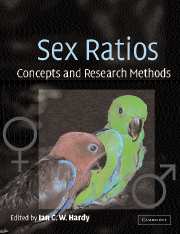Book contents
- Frontmatter
- Contents
- List of contributors
- Preface and acknowledgements
- Part 1 Sex ratio theory
- Part 2 Statistical analysis of sex ratio data
- Chapter 3 Statistical analysis of sex ratios: an introduction
- Chapter 4 Analysis of sex ratios in social insects
- Chapter 5 Analysis of sex ratio variances and sequences of sex allocation
- Chapter 6 Comparative analysis of sex ratios
- Part 3 Genetics of sex ratio and sex determination
- Part 4 Animal sex ratios under different life-histories
- Part 5 Sex ratios in plants and protozoa
- Part 6 Applications of sex ratios
- Index
- References
Chapter 5 - Analysis of sex ratio variances and sequences of sex allocation
Published online by Cambridge University Press: 06 August 2009
- Frontmatter
- Contents
- List of contributors
- Preface and acknowledgements
- Part 1 Sex ratio theory
- Part 2 Statistical analysis of sex ratio data
- Chapter 3 Statistical analysis of sex ratios: an introduction
- Chapter 4 Analysis of sex ratios in social insects
- Chapter 5 Analysis of sex ratio variances and sequences of sex allocation
- Chapter 6 Comparative analysis of sex ratios
- Part 3 Genetics of sex ratio and sex determination
- Part 4 Animal sex ratios under different life-histories
- Part 5 Sex ratios in plants and protozoa
- Part 6 Applications of sex ratios
- Index
- References
Summary
Summary
Sex ratio variances can indicate control of sex allocation beyond the production of a certain mean. Furthermore, theory predicts that nonbinomial (nonrandom) offspring-group sex ratio distributions should be selectively favoured in some circumstances. Mechanisms of producing nonbinomial sex ratio variances include the allocation of sex to offspring in fixed or other nonrandom sequences. Variances and sequences are thus linked. In this chapter we review predictions of sex ratio models, consider constraints and expectations arising from particular sex-determination mechanisms and discuss statistical methods for variance and sequence analysis.
Introduction
In Chapters 3 and 4 variance was treated as a consideration necessary to ensure appropriate data analysis. However, variance of offspring-group sex ratios are of interest in themselves both because they may be under selection and because they can indicate parental control of sex allocation. We begin by reviewing predictions of sex ratio models (section 5.3) and considering constraints and expectations arising from particular sex-determination mechanisms (section 5.4). We then introduce sex ratio ‘precision’ and its measurement (section 5.5) and give methods for statistical analysis of sex ratio variance (section 5.6). Sequences of sex allocation, and their relationships with sex ratio variance, are considered in section 5.7.
Variance expectations from optimality theory
Optimal sex-allocation theory makes predictions not just about mean sex ratios but also about variances. When mating opportunities extend throughout large populations (panmixis) the sex ratio within a group of offspring is selectively neutral as long as the population sex ratio remains at equilibrium (Kolman 1960).
- Type
- Chapter
- Information
- Sex RatiosConcepts and Research Methods, pp. 112 - 131Publisher: Cambridge University PressPrint publication year: 2002
References
- 25
- Cited by



